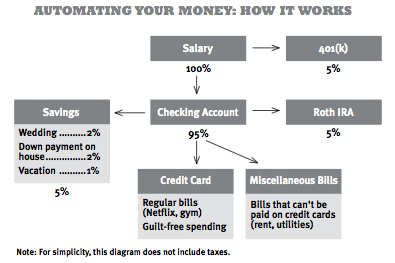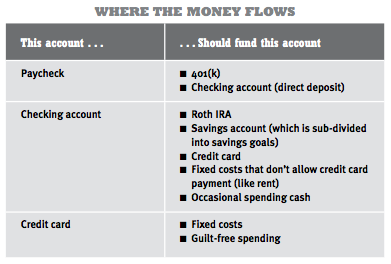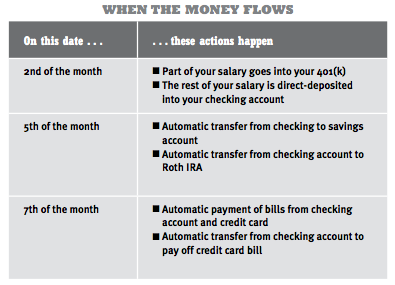I was inspired to write this blog based solely on having read Tim Ferriss’s The 4-Hour Workweek blog. It is the source of lots of interesting and great information and one of those blogs that I found particularly useful was contributed by his friend Ramit Sethi (co-founder PBWiki and author of best seller I Will Teach You To Be Rich). In the interests of transparency please know I have taken the liberty of editing and emphasizing parts of this original blog as I see fit. There is some Americanisation, but you will get the point.
Think about the 50+ money decisions you have to make today: Should you save more? What should you cut down on? What about investing — real estate or shares or index funds? Pay off debt? Did you send in that water bill on time? Is it time to rebalance your portfolio?
Faced with an overwhelming number of choices, most people respond in the same way: They do nothing. As Barry Schwartz explained in The Paradox of Choice … as the number of super funds in a retitrement plan offered to employees goes up, the likelihood that they will choose a fund — any fund — goes down. For every 10 funds added to the array of options, the rate of participation drops 2 percent. And for those who do invest, added fund options increase the chances that employees will invest in ultraconservative money-market funds.”
Why do so many people believe that personal finance is only about willpower? The idea goes like this: “If I just try harder, I’ll start saving more, pay off my debt, stop spending all that money, keep a budget, learn about investing, start investing, rebalance ever year…” Unlikely. It’s not about willpower. More than anything else, the psychology of automation is critical to successfully getting control of your finances.
In one study in the US, researchers found that making 401(k) (superannuation in Australia) accounts opt-out instead of opt-in— in other words, making employees automatically participate, although they could stop at any time — raised contribution rates from less than 40% to nearly 100%. ==>> so defaults matter.
And that is what this is all about. Automating the day-to-day decisions you have to make — paying bills, investing, rebalancing, cutting down on spending, increasing spending on things you love. That is your automated money flow will automatically route money where it needs to go — investments, paying bills, savings, and guilt-free spending— so you are not a slave to your personal finances and so you can focus on the things you care about.
Example : To see how this will work, let’s use Michelle as an example:

1. Michelle gets paid once a month. Her employer deducts 5 percent of her pay automatically and puts it in her 401(k) (super). The rest of Michelle’s paycheck goes to her checking account by direct deposit.
2. About a day later, her Automatic Money Flow begins transferring money out of her checking account via direct debits. Her Roth IRA retirement account will pull 5 percent of her salary for itself. Her savings account will pull 5 percent, automatically breaking that money into chunks: 2 percent for a wedding sub-account, 2 percent to a house down-payment sub-account, and 1% for an upcoming vacation. (That takes care of her monthly savings goals.)
3. Her system also automatically pays her fixed costs like gym, TV, and insurance. She’s set it up so that most of her subscriptions and bills are paid by her credit card. Some of her bills can’t be put on credit cards—for example, utilities and loans—so they’re automatically paid out of her checking account.
4. Finally, she’s automatically e-mailed a copy of her credit card bill for a monthly five-minute review before she pays that from her checking account (once a month).
5. The money that remains in her account is used for guilt-free spending money. To make sure she doesn’t overspend, she’s focused on two big wins: eating out and spending money on clothes. To track spending more easily, she uses her credit card as much as possible to pay for all of her fun stuff. If she uses cash for cabs or coffee, she keeps the receipts and tries to enter them into a spreadsheet or other budget system eg Mint as often as possible. She also keeps a reserve of $500 in her bank account just in case. In the middle of the month, Michelle’s calendar reminds her to check her Mint account / spending budget to make sure she’s within her limits for her spending money. If she’s doing fine, she gets on with her life. If she’s over her limit, she decides what she needs to cut back on to stay on track for the month. Luckily, she has fifteen days to get it right, and by politely passing on an invitation to dine out she gets back on track.
6. By the end of the month, she’s spent less than two hours monitoring her finances, yet she’s invested 10 percent, saved 5 percent (in sub-buckets for her wedding and down payment), paid all of her bills on time, paid off her credit card in full, and spent exactly what she wanted to spend. She had to say “no” only once, and it was no big deal. In fact, none of it was.
So to summarise – “The Next $100″ Principle Applied: Automating your Finances
Too many people try to save money on 50 things and end up saving 5% on everything — and causing themselves a huge amount of stress that makes them give up entirely. Instead, focus on your top two discretionary expenses (for me, eating out and going out), and cutting 25%-33% off over a period of six months. This generates hundreds of dollars of extra cash flow that you can re-route to investing and travel. So here’s the order of to do’s.
1. Set up automatic transfers – First, link your accounts together so you can set up automatic transfers from one account to another. This is really simple: It’s just a matter of working with each individual account’s website to make sure your payment or transfer is set up for the amount you want and on the date you want.

2. Don’t forget to change and automate dates – Most people neglect one thing when automating: dates. If you set automatic transfers at weird times, it will inevitably necessitate more work, which will make you resent and eventually ignore your personal-finance infrastructure. For example, if your credit card is due on the 1st of the month, but you don’t get paid until the 15th, how does that work? If you don’t synchronize all your bills, you’ll have to pay things at different times and that will require you to reconcile accounts. Which you won’t do.
The easiest way to avoid this is to get all your bills on the same schedule. To accomplish this, get all your bills together, call the companies, and ask them to switch your billing dates (eg from the 17th of each mont to the 1st of each month). Most of these will take five minutes each to do. There may be a couple of months of odd billing as your accounts adjust, but it will smooth itself out after that. If you’re paid on the 1st of the month, I suggest switching all your bills to arrive on or around that time, too.
Now that you’ve got everything coming at the beginning of the month, it’s time to actually go in and set up your transfers. Here’s how to arrange your Automatic Money Flow, assuming you get paid on the 1st of the month.
3. Understand the flows and let the automation begin !

- 2nd of the month: Part of your paycheck is automatically sent to your 401(k). The remainder (your “take-home pay”) is direct-deposited into your main bank account (checking account here). Even though you’re paid on the 1st, the money may not show up in your account until the 2nd, so be sure to account for that. Remember, you’re treating your main bank account like your e-mail inbox— first, everything goes there, then it’s filtered away to the appropriate place. Note: The first time you set this up, leave a buffer amount of money—I recommend $500—in your checking account just in case a transfer doesn’t go right. And don’t worry: If something does go wrong, you can always negotiate to get any fees waived. Call it growing pains if worst comes to worst.
- 5th of the month: Automatic transfer to your savings account. Log in to your savings account and set up an automatic transfer from your checking account to your savings account on the 5th of every month. Waiting until the 5th of the month gives you some leeway. If, for some reason, your paycheck doesn’t show up on the 1st of the month, you’ll have four days to correct things or cancel that month’s automatic transfer. Don’t just set up the transfer. Remember to set the amount, too. The amount you transfer from your main account into a separate savings account is entirely dependent on your budget. The key thing is that ‘out of sight, out of mind’). If you can’t see if and it is automatically transferred away you wont miss it and you wont spend it ! U
- 5th of the month: Automatic transfer to your investment account (whether that is another separate bak account or a fund manager account etc). Again, consult your budget to calculate the amount of the transfer. 10% is a good starting percentage.
- 7th of the month: Auto-pay for any monthly bills you have. Log in to any regular payments you have, like gym, utilities, car payments, or student loans, and set up automatic payments to occur on the 7th of each month. I prefer to pay my bills using my credit card, because I earn points and I can easily track my spending on online sites like Mint, Quicken, or Wesabe. And if your merchant doesn’t accept credit cards, they should let you pay the bill directly from your checking account, so set up an automatic payment from there if needed.
- 7th of the month: Automatic transfer to pay off your credit card. So you’ve just paid your monthly bills using your credit card and now you are paying off your credit card to ensure you don’t get into any trouble and aren’t paying the high interest rates etc. Log in to your credit card account and instruct it to draw money from your checking account and pay the credit card bill on the 7th of every month— in full. (Because your bill arrived on the 1st of the month, you’ll never incur late fees using this system.) NB: you have to be responsible here. If you have credit card debt and you can’t pay the bill in full, you can still set up an automatic payment; just make it for the monthly minimum. NB: As a tip. Set-up your credit card account so you get sent a monthly e-mail notification of your bill, so you can review it before the money is automatically transferred out of your checking account. This is helpful in case your bill unexpectedly exceeds the amount available in your checking account—that way you can adjust the amount you pay that month.
NB: Tweaking Your System: Freelancers, irregular income, and unexpected expenses
That’s the basic Automatic Money Flow schedule, but you may not be paid on a straight once-a-month schedule. That’s not a problem. You can just adjust the above system to match your payment schedule. eg If you’re paid twice a month: I suggest replicating the above system on the 1st and the 15th—with half the money each time. This is easy enough, but the one thing to watch with this is paying your bills. If the second payment (on the 15th) will miss the due dates for any of your bills, be sure that you set it so that those bills are paid in full during the payment on the 1st. Another way to work your system is to do half the payments with one paycheck (retirement, fixed costs) and half the payments with the second paycheck (savings, guilt-free spending), but that can get clunky.
If you have irregular income: Irregular incomes, like those of freelancers, are difficult to plan for. Some months you might earn close to nothing, others you’re flush with cash. You therefore need to allow for this. First figre out your bare minimum costs per month eg rent, uttilities, food. Don’t invest until you have a buffer of 3 months bare-bones income. For example, if you need at least $1,500/month to live on, you’ll need to have $4,500 in a savings buffer, which you can use to smooth out months where you don’t generate much income. The buffer should exist as a sub-account in your savings account.
Your money is now automatic – Your money management is now on autopilot. Not only are your bills paid automatically and on time, but you’re actually saving and investing money each month. The beauty of this system is that it works without your involvement and it’s flexible enough to add or remove accounts any time. You’re accumulating money by default. Most importantly, whenever you’re eating out, or you decide to buy a new pair of shoes or fly out to visit your friends or get the “Pro” version of that web app you’ve been eyeing, you won’t feel guilty because you’ll KNOW that your finances are being handled — automatically.
Smart hey ! … And just in time for Christmas and the New Year. DO IT !


Excellent post with some good info, think i’ll share this on my twitter if you don’t mind and maybe even blogroll it depending on the feedback, thanks for sharing.
Hello, it’s a really nice article, and great revue.